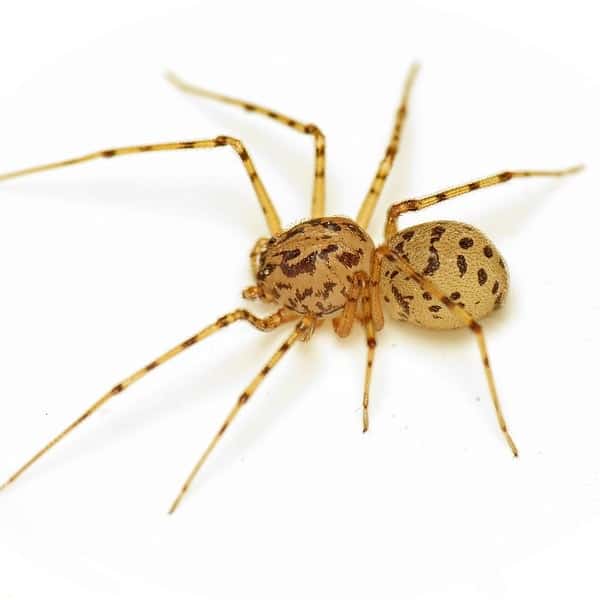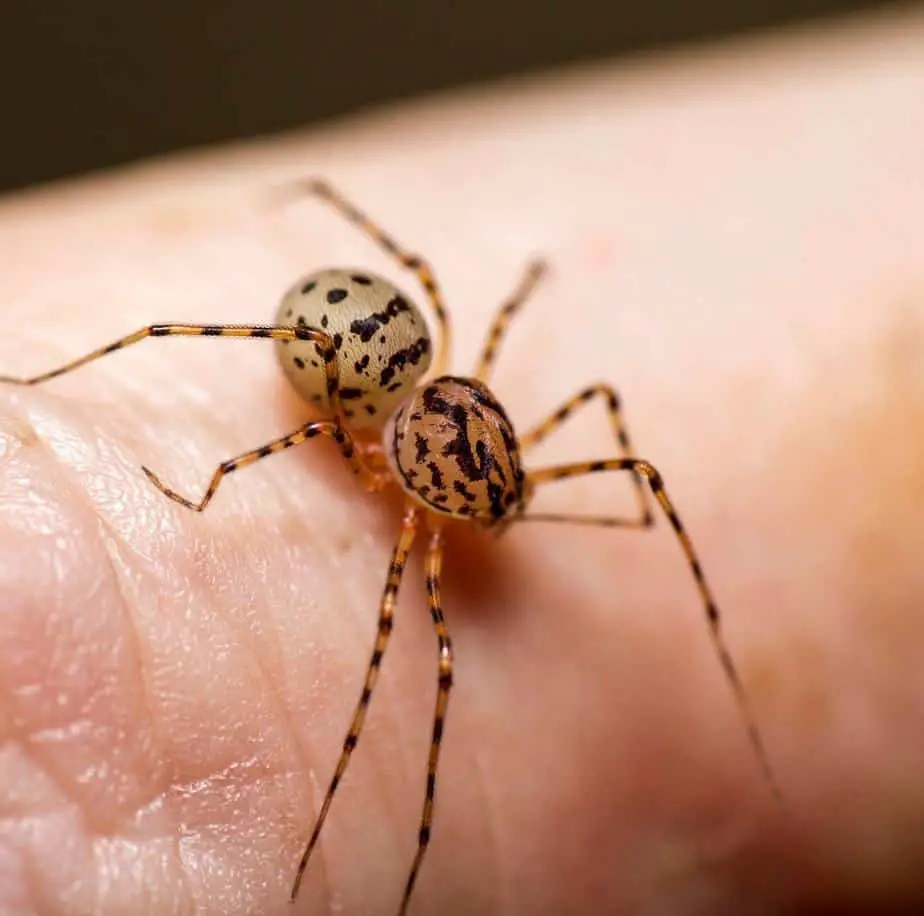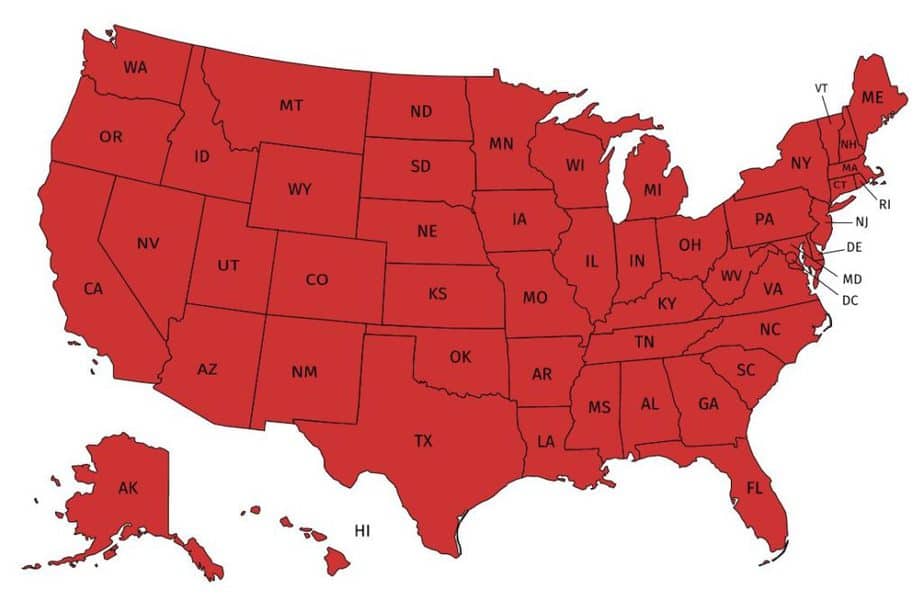The spitting spider, scientifically called Scytodaes thoracica, is a fascinating type of hunting spider that captures and paralyzes its prey with sticky venomous silk strands that it shoots from its head. The spitting spider occurs throughout the world and can be found in every U.S. State.
Spitting Spider Description
The spitting spider has a very characteristic look and the identification is generally very easy. The most telling characteristic is its body coloration. The entire body is a light brown with darker brown dots and patterns. The legs are light brown with several darker bands.

Another way to tell a spitting spider from other spiders is the size of abdomen and cephalothorax. Most spiders have a larger abdomen (the back part of the body). The cephalothorax of the spitting spider, on the other hand, is mostly larger than its abdomen. The cephalothorax is dome-shaped. A closer look at the eye area reveals that spitting spiders only have six eyes. Most other spiders have eight eyes. They form two groups of two eyes each. Two on top and one further down in the center.
Size
An adult female spitting spider reaches an average body size of 0.15-0.25 inches (4-6 mm). They can reach a total leg span of around 0.75 inches (18 mm). Male spitting spiders are slightly smaller than females.

Scytodes thoracica Web
Most spiders have their silk glands, that they use to spin webs, on their abdomen. In addition to that, the spitting spider has two additional silk glands on their cephalothorax (head) that are connected to its venom glands. This allows the spider to spit silk strings from its head that are covered in a sticky, venomous liquid that paralyzes its prey.
Since the spitting spider is a hunting spider, it does not spin a web to catch flying or roaming creatures.
Spitting Spider Hunting Behavior
Below, you can see a video of the peculiar hunting behavior of the spitting spider. The spider starts hunting at nighttime. It slowly approaches small prey like insects or other spiders. Once it has moved into a range of 0.5-0.75 inches of the prey, it stretches out one of the front legs to measure the distance to the prey. It does so with extreme caution without the prey noticing that is being watched. Once the exact distance is measured, the spitting spider emits to spurts of liquid, venomous silk over its prey that solidifies and shrinks in contact with air. This immediately captures and immobilizes the prey. The spitting spider continues spraying the prey until it is completely immobilized. After that, the spider moves in for a final bite before wrapping it up in silk.
Spitting Spider Bite
It spits venomous silk on top of it and paralyzes the small insects or spiders that it hunts. For humans, the spitting spider is absolutely harmless. The spitting spider only spits its venomous silk onto immobile, small animals and would not attack a larger pet or a person. And even if it would, the venom on the silk would not be strong enough to cause any reaction. Its fangs are not strong enough to pierce through human skin.
Spitting Spider Range in the USA

The spitting spider can be found throughout the world and occurs in every U.S. state. Sightings of spitting spiders are more common in the Eastern United States but occasionally, specimen are also seen in the Western United States. It is still unclear whether the spider is native to the Western U.S. or if sightings only occur from an imported specimen. However, it is not unlikely that you will encounter a spitting spider in any of these states: Alabama, Alaska, Arizona, Arkansas, California, Colorado, Connecticut, Delaware, Florida, Georgia, Hawaii, Idaho, Illinois, Indiana, Iowa, Kansas, Kentucky, Louisiana, Maine, Maryland, Massachusetts, Michigan, Minnesota, Mississippi, Missouri, Montana, Nebraska, Nevada, New Hampshire, New Jersey, New Mexico, New York, North Carolina, North Dakota, Ohio, Oklahoma, Oregon, Pennsylvania, Rhode Island, South Carolina, South Dakota, Tennessee, Texas, Utah, Vermont, Virginia, Washington, West Virginia, Wisconsin, Wyoming
Scytodes thoracica Scientific Classification
- Kingdom: Animalia
- Phylum: Arthropoda
- Subphylum: Chelicerata
- Class: Arachnida
- Order: Araneae
- Infraorder: Araneomorphae
- Family: Scytodidae
- Genus: Scytodes
- Species: Scytodes thoracica


I’ve been finding this species in and around my home in south Florida, usually on an indoors wall. It makes no web, is only about 1 cm (1/25 “). It doesn’t move, for weeks at a time, unless touched.
I was able to acquire this one by putting a drop of glycerin on a needle, and then touching the glycerined needle point to the spider. I positioned in over a microscope slide, and put a drop of nail polish on top of it to make a permanent microscope specimen mount. The image is clearer in the microscope than on the iPhone photo, sorry.
It appears that this spider is translucent mostly.
Your thoughts??
Hello Mike, cool find! This appears to be a spitting spider. They don’t build webs, but spit sticky silk through their “mouths” to immobilize their prey. Fascinating spiders! You can read more about spitting spiders here: https://usaspiders.com/scytodes-thoracica-spitting-spider/
Found this interesting 6 eye chap, hanging out on a downspout near some cobweb spiders but not really looking like he belongs.clearest image I can find anywhere that is similar is the Mediterranean recluse. But would love an opinion
Hello Nate, thanks for getting in touch. This is most likely a spitting spider (Scytodes sp.). They are not medically significant. Here is a photo of the eye pattern similar to your spider: https://bugguide.net/node/view/105208
You can read more about spitting spiders in this post: https://usaspiders.com/scytodes-thoracica-spitting-spider/
Your spider is possibly Scytodes atlacoya – depends also on where you found the spider. Would you mind sharing the location?
Daddy long leg like
Hello Calem, thanks for sharing this great image. This is a spitting spider (Scytotidae sp.): https://usaspiders.com/scytodes-thoracica-spitting-spider/
Wilmington NC This wispy spider (about 1” including legs) resembles brown recluses I saw in the Midwest but the marking is not a definite violin. It may have come in with our dog who likes to sit in the bathroom, or may have made its way onto the shower wall on its own. I sprayed it with bleach in case it was a bad guy.
Hello Cathy, this is definitely not a bad guy. This is a male spitting spider (Scytodes sp.) – a fascinating spider: https://usaspiders.com/scytodes-thoracica-spitting-spider/
Enid, Oklahoma – This spitting spider was found in a sticky trap in the kitchen area of the home which was set to trap brown recluses which we have not seen in our house for over nine years of residency. In dim light I thought it may be a recluse, but the pattern was definitely not fiddle shaped under good light. I am glad to find this spider’s identification and its harmlessness to humans, and hope NOT to catch another.
Found in my coffee mug!
Las Vegas NV
Hi Alex, this is a spitting spider (Scytodes sp.): https://usaspiders.com/scytodes-thoracica-spitting-spider/
They are fascinating spiders, not dangerous for humans.
very small, probably less than an inch total. found it in my hallway at night, i’m in southern arizona. i was too scared to get closer i’m so scared of spiders, just want to know if it’s dangerous for me or my pets (small dogs and a cat). also is it a baby? i saw a bigger spider (maybe 2 inches including the legs? i think it had hairs but i didn’t look too close for very long) a few days ago that kinda looks like it, but im not sure. i didn’t get a pic of that one too scary lol. always find spiders in our house after the monsoon rains
Hi Liz, this is a spitting spider (Scytodes sp.). They are very fascinating spiders as they can spit venomous silk – they are absolutely not dangerous for humans or pets and great to have around as they catch other, possibly more dangerous spiders. Here is more information about them: https://usaspiders.com/scytodes-thoracica-spitting-spider/
Found in shower, its cooler in there due to poor insulation. Oklahoma City, Oklahoma
Hi Jes, this is some type of spitting spider: https://usaspiders.com/scytodes-thoracica-spitting-spider/
Found 3 in my house this weekend. All hanging on walls.
Found this guy after stepping over it….is this a spitting spider?
Found this spitting spider with its prey in my house.